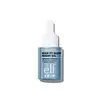What's inside
What's inside
 Key Ingredients
Key Ingredients

 Benefits
Benefits

 Concerns
Concerns

 Ingredients Side-by-side
Ingredients Side-by-side

Caprylic/Capric Triglyceride
MaskingHelianthus Annuus Seed Oil
EmollientTocopherol
AntioxidantVitis Vinifera Seed Oil
EmollientSimmondsia Chinensis Seed Oil
EmollientPersea Gratissima Oil
Skin ConditioningLimnanthes Alba Seed Oil
Skin ConditioningDimethyl Isosorbide
SolventHydroxypinacolone Retinoate
Skin ConditioningStearyl Glycyrrhetinate
Skin ConditioningVaccinium Angustifolium Fruit Extract
Skin ProtectingChamomilla Recutita Flower Oil
MaskingBorago Officinalis Seed Oil
EmollientEthylhexylglycerin
Skin ConditioningPentaerythrityl Tetracocoate
EmollientCI 61565
Cosmetic ColorantCI 60725
Cosmetic ColorantCaprylic/Capric Triglyceride, Helianthus Annuus Seed Oil, Tocopherol, Vitis Vinifera Seed Oil, Simmondsia Chinensis Seed Oil, Persea Gratissima Oil, Limnanthes Alba Seed Oil, Dimethyl Isosorbide, Hydroxypinacolone Retinoate, Stearyl Glycyrrhetinate, Vaccinium Angustifolium Fruit Extract, Chamomilla Recutita Flower Oil, Borago Officinalis Seed Oil, Ethylhexylglycerin, Pentaerythrityl Tetracocoate, CI 61565, CI 60725
 Reviews
Reviews

Ingredients Explained
These ingredients are found in both products.
Ingredients higher up in an ingredient list are typically present in a larger amount.
This ingredient is an emollient, solvent, and texture enhancer. It is considered a skin-softener by helping the skin prevent moisture loss.
It helps thicken a product's formula and makes it easier to spread by dissolving clumping compounds.
Caprylic Triglyceride is made by combining glycerin with coconut oil, forming a clear liquid.
While there is an assumption Caprylic Triglyceride can clog pores due to it being derived from coconut oil, there is no research supporting this.
Learn more about Caprylic/Capric TriglycerideThis oil comes from the seeds of the desert shrub called Jojoba. It is more commonly known as jojoba oil, a non-comedogenic oil.
Jojoba oil does not contain fragrance and has many fatty-acids, making it a great soothing ingredient.
It also contains Vitamin E, a great moisturizing ingredient. Vitamin E is also an antioxidant and protects your skin against oxidative damage.
This ingredient humectant properties, meaning it helps draw moisture from the air. This helps keep your skin hydrated.
While jojoba has antibacterial properties, it is only able to kill some strains of bacteria.
Studies also show it helps in wound healing. In fact, Indigenous cultures have used jojoba as a moisturizer and to help treat burns for centuries.
Fun fact: Jojoba oil similar to natural human skin sebum, so it has a great effect on dry skin. It is also promising with helping to regulate sebum production.
Due to its fatty acid content, Jojoba oil may not be fungal acne safe. We recommend speaking with a professional if you have any concerns.
Learn more about Simmondsia Chinensis Seed Oil